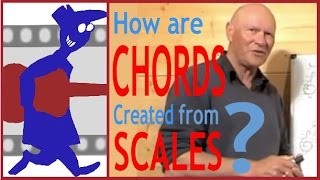Understanding Key Signatures - Part 7
Published on 26 January 2016
For more information from the source site of this video please visit: http://secretguitarteacher.com/youtube/advanced/theory/xZr5rp6-gkw/84145580-understanding-key-signatures-7.php
Notice that the order of double flats is starting to follow our mnemonic... B...E ... Battle Ends...So we can start to safely predict what happens next...
So far we have
Let's work through the next couple of keys quickly..
Now you may well be ahead of me here if you have just followed the last lesson, where we completed the circle of fifths, but give me the satisfaction of completing this for you! ... we are in the key of Abb major and we take the fourth note which is Dbb
Dbb Ebb Fb Gbb Abb Bbb Cb Dbb
It appears to have 12 flats which is beginning to get a bit silly isn't it?!
So we simplify it by converting to enharmonics with shorter note names.. What's another name for the note Dbb?...
Dbb Ebb Fb Gbb Abb Bbb Cb Dbb
C D E F G A B C
So, once again we have come full circle back to the neutral key of C major.
So there we have the complete picture at last!
Now why did I say that you will almost never encounter pieces of music written in keys that involve double sharps?
Well the answer lies in the circle.
If you take any one segment of enharmonic keys, there is usually an obvious choice to make:
Look at the segment at 3 o'clock -- given the choice between working in the key of A major with its 3 sharps or Bbb major with 9 sharps -- which are you more likely to choose?
Are you going to write in C## minor with 11 sharps, or choose the key of D minor with one Flat in the key signature? The result sounds the same -- its just a question of which is simpler the THINK in and WORK in.
This answers a question that I have to say mystified me for ages when I was growing up with learning music -- why have two different names for each black note on the piano keyboard. Why sharps and flats?
Well, you have to have worked all the way up the music theory pyramid to this stage, to really get a full appreciation of why we need two (or more) ways of naming the same note! But ultimately, there is a rather elegant system at work here. There may be a simpler, comprehensive system of naming musical notes, but I have to say I have been keeping my eyes open for more than 45 years and haven't spotted one yet!
Finally, notice that at the bottom of the circle things are not quite so clear cut. The choice between whether to write in Gb major or F# major, for example, is exactly six of one and half a dozen of the other -- 6 sharps in F# Major or 6 flats in Gb major.
Even the keys either side -- most musicians have a leaning towards sharp or flat keys. Most guitar players, being naturally more comfortable with sharps
than flats, would probably opt for C#Major with 7 sharps rather than the enharmonic key of Db, which has 5 flats. A sax player, being more used to flat keys may prefer Ab minor with 7 flats over G# minor with only five sharps.
Each Major key is shown next to its relative minor key.
Relative keys share the same key signature (shown in Black)
The Outer circle shows the progression of the keys in the circle of Fifths which, apart from the keys of C major/A minor, all have sharps in their key signature.
The Inner circle shows the progression of the keys in the circle of Fourths which, apart from the keys of C major/A minor, all have flats in their key signature.
The lighter the background, the more commonly the key is used.
Keys with dark backgrounds are almost never used because of the availability of significantly simpler enharmonic keys from the other circle.
If you are watching this video as a member of the SecretGuitarTeacher.com website you can download a printout of
this circle from the toolbox -- it makes a great wall poster!
Hope this series of lessons has helped to take the mystery out of the whole subject of key signatures. This is very core material. Unless you have a good grasp of this circle, you are going to run into great difficulties further on in music theory studies, so, do take your time and go back over the lessons to clarify the details.
One very good way to bed in the information is to leave it a couple of days then see if you can sketch out this circle for yourself. If you can, it's a safe bet that you've understood the theory behind it.
Once you are ready to move on, I recommend the lessons on Harmonising the Major scale next -- they link very directly to these lessons and you will need to work with this info to make sense of those lessons so it's good application.
OK, whichever course you choose I look forward to seeing you in the next lesson!
See You then!
 IMPROVISATION: 3 Steps to Meaningful Solos
IMPROVISATION: 3 Steps to Meaningful Solos
 Understanding Key Signatures - Part 5
Understanding Key Signatures - Part 5
 Wah Pedal Guitar Lesson With Michael Casswell | Li...
Wah Pedal Guitar Lesson With Michael Casswell | Li...
 Minor Triad Voicings
Minor Triad Voicings
 3 Beginner Fingerstyle Riff Exercises - Guitar Les...
3 Beginner Fingerstyle Riff Exercises - Guitar Les...
 How To Play Perfect Power Chords
How To Play Perfect Power Chords
 How to Embellish a Dm Chord
How to Embellish a Dm Chord
 Guitar Theory: Voice Leading & Chord Inversions
Guitar Theory: Voice Leading & Chord Inversions
 There is only one chord shape on the guitar - Part...
There is only one chord shape on the guitar - Part...
 Composing 3-Part Guitar Harmony
Composing 3-Part Guitar Harmony







